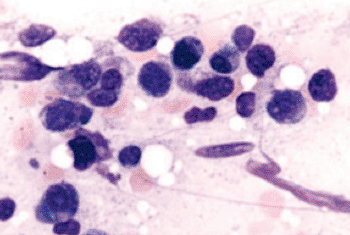Congenital Anemia Patients Should Be Tested for Pearson Syndrome
By LabMedica International staff writers
Posted on 19 Dec 2013
Some infants diagnosed with and treated for a bone marrow failure disorder, called Diamond Blackfan Anemia, may actually be affected by a very rare anemia syndrome that has a different disease course and treatment.Posted on 19 Dec 2013
Diagnosing the rare Pearson Marrow Pancreas syndrome (PS) is not simple, but a specific laboratory test can spot a characteristic abnormality in the infant's DNA that carries blueprints for making proteins in the cells' energy-producing mitochondria.

Image: Bone marrow smear from a patient with Diamond Blackfan Anemia (Photo courtesy of American Society of Hematology).
Scientists at the Dana-Farber Cancer Institute (Boston, MA, USA) genetically analyzed DNA from 175 patients believed to have Diamond Blackfan Anemia, and identified 8 that showed hallmarks of PS. The two disorders are caused by genetic abnormalities that impair production of blood cells by the bone marrow, causing severe anemia usually diagnosed in the first year of life.
Diamond Blackfan Anemia is typically inherited from parents in an autosomal dominant fashion, with only one parent carrying the abnormal gene, so each pregnancy carries a 50% risk of resulting in an affected child. Diamond Blackfan Anemia affects approximately 1 in 100,000 infants and can vary widely in its severity. About 50% of patients have physical abnormalities affecting different parts of the body.
Infants with PS also have anemia and growth defects. They are deficient in pancreatic function and can have muscle and neurologic impairments. It is not always diagnosed in infancy, because the anemia may not be severe and can even improve without treatment. That is because the patient's cells carry a mixture of normal and mutant mitochondrial DNA. Over time, the proportion of mutant mitochondrial DNA in the blood cells may lessen and the anemia becomes less severe.
Suneet Agarwal, MD, PhD, a pediatric hematologist, said, “Some patients with Diamond Blackfan will respond to steroids, but there's no reason to give steroids to someone with Pearson Syndrome and they could make things worse. Most patients with Diamond Blackfan Anemia require blood transfusions into adulthood. If you're going to do a transplant in a patient with Diamond Blackfan, outcomes are better if you do it early. Because patients with Pearson Syndrome can get over their blood defect as young children, and because bone marrow transplantation does not cure the other problems in their bodies, the decision to proceed with transplant is more difficult.” The study was presented at the 55th annual meeting of the American Society of Hematology held December 7–10, 2103, in New Orleans, (LA, USA).
Related Links:
Dana-Farber Cancer Institute














